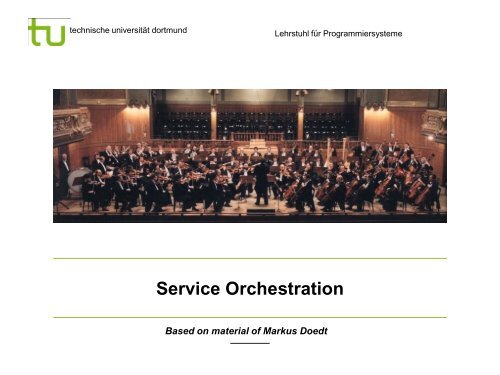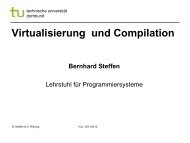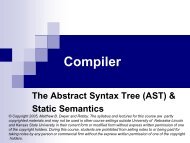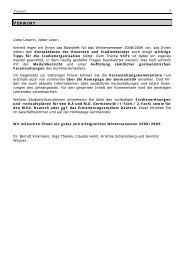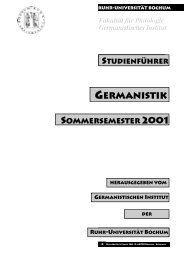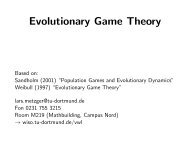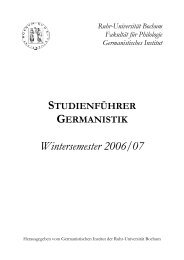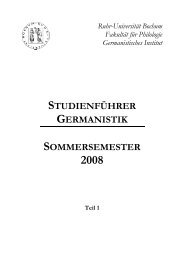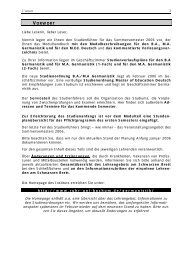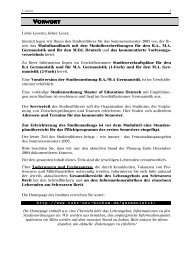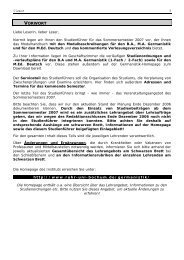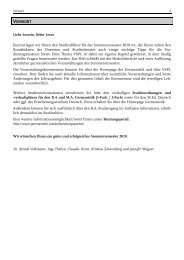BPEL und BPEL-Engines
BPEL und BPEL-Engines
BPEL und BPEL-Engines
Create successful ePaper yourself
Turn your PDF publications into a flip-book with our unique Google optimized e-Paper software.
technische universität dortm<strong>und</strong>Lehrstuhl für ProgrammiersystemeSOA• paradigm rather than technology• central ideaso domain: business processeso services loosely coupled reusable autonom statelesso interoperations of services standardized interfaces orchestrationMarkus Doedt / O. Rüthing - VuC 2010/11
technische universität dortm<strong>und</strong>Lehrstuhl für ProgrammiersystemeFrom the idea to a running processideamodellingprocess modelgenerationexecutableprocess definitiondeploymentrunning processinstancese.g. BPMN?<strong>BPEL</strong>EngineMarkus Doedt / O. Rüthing - VuC 2010/11
technische universität dortm<strong>und</strong>Lehrstuhl für ProgrammiersystemeProcess engine vs. JavaVM• Both are virtual machines which execute “something”(business process Java bytecode)• Provide an abstraction layer above something really complicated• Provide standard functionalitiesMarkus Doedt / O. Rüthing - VuC 2010/11
technische universität dortm<strong>und</strong>Lehrstuhl für ProgrammiersystemeProcess engine vs. JavaVM• Both are virtual machines which execute “something”(business process Java bytecode)• Provide an abstraction layer above something really complicated• Provide standard functionalitiesMarkus Doedt / O. Rüthing - VuC 2010/11
technische universität dortm<strong>und</strong>Lehrstuhl für ProgrammiersystemeProcess Engine ( = Process Server )• A server application which is able to execute busines processes.• Business process:„…a structured, measured set of activities designed toproduce a specific output for a particular customer or market.“(Davenport, 1993)• What language can a process engine execute?Markus Doedt / O. Rüthing - VuC 2010/11
technische universität dortm<strong>und</strong>Lehrstuhl für Programmiersysteme<strong>BPEL</strong>• WS-<strong>BPEL</strong>: Web Services Business Process Execution Language• Process modelling/specification/description language• Based on XML• All activities are web services.• A <strong>BPEL</strong>-Process can be beployed as a web service itself.• „Programming in the large“Markus Doedt / O. Rüthing - VuC 2010/11
technische universität dortm<strong>und</strong>Lehrstuhl für ProgrammiersystemeSOA / BPMQuelle: Sun MicrosystemsMarkus Doedt / O. Rüthing - VuC 2010/11
technische universität dortm<strong>und</strong>Lehrstuhl für ProgrammiersystemeTechnologies• Orchestration: <strong>BPEL</strong>• Definition of services (interfaces): WSDL• Message format: XML• „Protocol“: SOAP• Transport of the message: HTTPMarkus Doedt / O. Rüthing - VuC 2010/11
technische universität dortm<strong>und</strong>Lehrstuhl für ProgrammiersystemeHistory of <strong>BPEL</strong>• December 2000: XLANG (Microsoft)• March 2001: WSFL (IBM)• July 2002: <strong>BPEL</strong>4WS 1.0(Microsoft, IBM, BEA, SAP, Siebel)• March 2003: <strong>BPEL</strong>4WS is submitted to OASIS• May 2003: OASIS publishes <strong>BPEL</strong>4WS 1.1• April 2007: WS-<strong>BPEL</strong> 2.0 official OASIS standardMarkus Doedt / O. Rüthing - VuC 2010/11
technische universität dortm<strong>und</strong>Lehrstuhl für Programmiersysteme<strong>BPEL</strong> Syntax• Root element: …• Partner Links and Partner Link Types• Variables: XML-Schema is used for the types• Importing of WSDL- and XSD-Files• Correlation Sets• Basic Activities• Structured Activities• HandlersMarkus Doedt / O. Rüthing - VuC 2010/11
technische universität dortm<strong>und</strong>Lehrstuhl für ProgrammiersystemeExample processSequencingSynchronizationSource: WS-<strong>BPEL</strong> 2.0 Specification (OASIS)Markus Doedt / O. Rüthing - VuC 2010/11
technische universität dortm<strong>und</strong>Lehrstuhl für ProgrammiersystemePartner Links• interface description• in WDSL• loose couplingSource: WS-<strong>BPEL</strong> 2.0 Specification (OASIS)Markus Doedt / O. Rüthing - VuC 2010/11
technische universität dortm<strong>und</strong>Lehrstuhl für Programmiersysteme<strong>BPEL</strong>-Specification• For the example refer to the pages 19-21 from the WS-<strong>BPEL</strong> 2.0specification.Markus Doedt / O. Rüthing - VuC 2010/11
technische universität dortm<strong>und</strong>Lehrstuhl für ProgrammiersystemeBasic activities• • and • • • • • (until <strong>BPEL</strong> 1.1: )Markus Doedt / O. Rüthing - VuC 2010/11
technische universität dortm<strong>und</strong>Lehrstuhl für ProgrammiersystemeStructured activities• • (bis <strong>BPEL</strong> 1.1: )• …………• (new since <strong>BPEL</strong> 2.0)• (new since <strong>BPEL</strong> 2.0)• • Markus Doedt / O. Rüthing - VuC 2010/11
technische universität dortm<strong>und</strong>Lehrstuhl für ProgrammiersystemeScopes• Local variable scopes (comparable to the “context“ in jABC)• Can have their own‣ Fault Handlers‣ Compensation Handlers‣ Event Handlers• No real hierarchy! No subprocesses!Markus Doedt / O. Rüthing - VuC 2010/11
technische universität dortm<strong>und</strong>Lehrstuhl für Programmiersysteme<strong>BPEL</strong> Extensions• <strong>BPEL</strong>4People(and WS-Human Task)• <strong>BPEL</strong>J• <strong>BPEL</strong>-SPE(WS-<strong>BPEL</strong> 2.0 Extensions for Sub-Processes)Markus Doedt / O. Rüthing - VuC 2010/11
technische universität dortm<strong>und</strong>Lehrstuhl für ProgrammiersystemeFrom the idea to a running processideamodellingprocess modelgenerationexecutableprocess definitiondeploymentrunning processinstancese.g. BPMN?<strong>BPEL</strong>EngineMarkus Doedt / O. Rüthing - VuC 2010/11
technische universität dortm<strong>und</strong>Lehrstuhl für ProgrammiersystemeBPMN• Business Process Modeling Notation• 2000: developed by Stephen A. White (IBM),published by BMPI (Business Process Management Initiative)• July 2005: BMPI merges with OMG (Object Management Group)• 2006: BPMN is official OMG standardMarkus Doedt / O. Rüthing - VuC 2010/11
technische universität dortm<strong>und</strong>Lehrstuhl für ProgrammiersystemeBPMN• Graphical language• Not directly executable• Alternatives:‣ UML Activity Diagrams‣ EPC (Event-driven Process Chains) from ARIS (IDS Scheer)‣ State Charts‣ Petri Nets / Colored Petri Nets‣ YAWL‣ jABC (last but not least)‣ …and many more…Markus Doedt / O. Rüthing - VuC 2010/11
technische universität dortm<strong>und</strong>Lehrstuhl für ProgrammiersystemeBPMN ExampleMarkus Doedt / O. Rüthing - VuC 2010/11
technische universität dortm<strong>und</strong>Lehrstuhl für ProgrammiersystemeBPMN ExampleMarkus Doedt / O. Rüthing - VuC 2010/11
technische universität dortm<strong>und</strong>Lehrstuhl für ProgrammiersystemeFrom the idea to a running processideamodellingprocess modelgenerationexecutableprocess definitiondeploymentrunning processinstancese.g. BPMN<strong>BPEL</strong>EngineMarkus Doedt / O. Rüthing - VuC 2010/11
technische universität dortm<strong>und</strong>Lehrstuhl für ProgrammiersystemeFeatures of process engines• Executing processes (with correct semantics)• Persistence• Scalability• Support for “human interactions”• Support for “long running transactions”• Versioning of process definitions• Monitoring applicationMarkus Doedt / O. Rüthing - VuC 2010/11
technische universität dortm<strong>und</strong>Lehrstuhl für ProgrammiersystemeFeatures of process engines• Executing processes (with correct semantics):‣ Proprietary extensions of the vendors‣ Sometimes not all features of a language are implemented‣ Semantics of the language (sometimes) not formally specified(e.g. <strong>BPEL</strong>).• WS-<strong>BPEL</strong> 2.0 tries to be more clear than <strong>BPEL</strong>4WS 1.1(264 pages 136 pages)• Computer scientists try to define the semantics of <strong>BPEL</strong> by means of- Petri Nets- Process algebras (and SOS: Structured Operational Semantics)- …(other formal languages)…Markus Doedt / O. Rüthing - VuC 2010/11
technische universität dortm<strong>und</strong>Lehrstuhl für ProgrammiersystemePersistence• Possibility of resuming a process after a server-crash.• RDBMS (Relational database management systems)• Persistence of‣ The state of the process: What activity is the current one?‣ The state of the context: What are the values of the variables?‣ History:• How often was a process executed?• When was it executed?• Whas the execution always succesfull?• …(and much more)…Markus Doedt / O. Rüthing - VuC 2010/11
technische universität dortm<strong>und</strong>Lehrstuhl für ProgrammiersystemeScalability• Support for a huge number of‣ process definitions‣ clients‣ process instances• Automatic clustering• E.g. by using a JEE application server(like JBoss, Glassfish, IBM Websphere, …)Markus Doedt / O. Rüthing - VuC 2010/11
technische universität dortm<strong>und</strong>Lehrstuhl für ProgrammiersystemeSupport for “human interactions”• Interactions with humans as part of the process language.• Like <strong>BPEL</strong>4People and WS-HumanTask• Today still often proprietary solutions.Markus Doedt / O. Rüthing - VuC 2010/11
technische universität dortm<strong>und</strong>Lehrstuhl für ProgrammiersystemeSupport for “long running transactions”• Human interaction can take a long time.• The server should not actively wait for the interaction.‣ Whould not be good for the scalability.• Processes must be persisted and erased from the memory whenthey are not active.Markus Doedt / O. Rüthing - VuC 2010/11
technische universität dortm<strong>und</strong>Lehrstuhl für ProgrammiersystemeVersioning of process definitions• New versions of process definitions can be deployed.• New instances of the process should use the new version.• What happens with running instances?‣ Continue with the old version?‣ Migrate to the new version?It depends on thescenario, theapplication field etc…• Old versions must stay on the server.‣ E.g. for the history function.Markus Doedt / O. Rüthing - VuC 2010/11
technische universität dortm<strong>und</strong>Lehrstuhl für ProgrammiersystemeMonitoring application• The process engine is „process aware“.• The process can be monitored (observed by a user or admin).• Live monitoring (e.g. graphically)• History of the processes‣ What path took the process?‣ When did it start?‣ How long did each activity take?‣ …Markus Doedt / O. Rüthing - VuC 2010/11
technische universität dortm<strong>und</strong>Lehrstuhl für ProgrammiersystemeProducts: Editors• ActiveVOS Designer by active endpoints(BPMN-view + graphical <strong>BPEL</strong>-view)• Intalio Designer (BPMN)• Oracle <strong>BPEL</strong> Process Manager• Eclipse <strong>BPEL</strong>-Plugin• Netbeans <strong>BPEL</strong> DesignerMarkus Doedt / O. Rüthing - VuC 2010/11
technische universität dortm<strong>und</strong>Lehrstuhl für ProgrammiersystemeProdukte: <strong>Engines</strong> (Open Source)• Active<strong>BPEL</strong> by active endpoints• Apache Ode• jBPM by JBossMarkus Doedt / O. Rüthing - VuC 2010/11
technische universität dortm<strong>und</strong>Lehrstuhl für ProgrammiersystemeProducts: <strong>Engines</strong> (commercial)• ActiveVOS (commercial variant of Active<strong>BPEL</strong>)• Intalio Server (based on Apache Ode)• Oracle <strong>BPEL</strong> Process Manager• IBM WebSphere Process Server• Microsoft BizTalk Server(Windows Workflow Fo<strong>und</strong>ation)• SAP Process Integration (since version 3.0)Markus Doedt / O. Rüthing - VuC 2010/11
technische universität dortm<strong>und</strong>Lehrstuhl für ProgrammiersystemeSpecifications• WS-<strong>BPEL</strong> 2.0:http://docs.oasis-open.org/wsbpel/2.0/wsbpel-v2.0.pdf (OASIS)• WSDL 1.1: http://www.w3.org/TR/wsdl (W3C)• SOAP 1.2: http://www.w3.org/TR/soap/ (W3C)• XML 1.0: http://www.w3.org/TR/REC-xml/ (W3C)• HTTP 1.1: http://www.w3.org/Protocols/rfc2616/rfc2616.html (W3C)• WS-<strong>BPEL</strong>4People: http://tinyurl.com/6sacto (at SAP)• WS-HumanTask: http://tinyurl.com/62la9t (SAP)• BPMN 1.1: http://www.bpmn.org/ (OMG)Markus Doedt / O. Rüthing - VuC 2010/11
technische universität dortm<strong>und</strong>Lehrstuhl für ProgrammiersystemeProduct websites• ActiveVOS: http://www.activevos.com/• Intalio: http://www.intalio.com/• Oracle <strong>BPEL</strong> Process Manager:http://www.oracle.com/technology/bpel• Eclipse <strong>BPEL</strong> Project: http://www.eclipse.org/bpel/• Netbeans <strong>BPEL</strong> Designer: http://www.netbeans.org/features/soa/• Apache Ode: http://ode.apache.org/• JBoss jBPM: http://www.jboss.com/products/jbpm• IBM Websphere Process Server:http://www-01.ibm.com/software/integration/wps/• Microsoft Biztalk Server: http://www.microsoft.com/germany/biztalk• SAP Process Integration: http://tinyurl.com/6km44Markus Doedt / O. Rüthing - VuC 2010/11
technische universität dortm<strong>und</strong>Lehrstuhl für ProgrammiersystemeLiterature• Matjaz B. Juric: Business Process Execution Language for WebServices, 2006, Packt Publishing• BEA + IBM: <strong>BPEL</strong>J: <strong>BPEL</strong> for Java (Whitepaper), 2004,http://ftpna2.bea.com/pub/downloads/ws-bpelj.pdf• SAP + IBM: WS-<strong>BPEL</strong> Extension for Sub-processes – <strong>BPEL</strong>-SPE(Whitepaper), 2005, http://tinyurl.com/a524ncMarkus Doedt / O. Rüthing - VuC 2010/11


